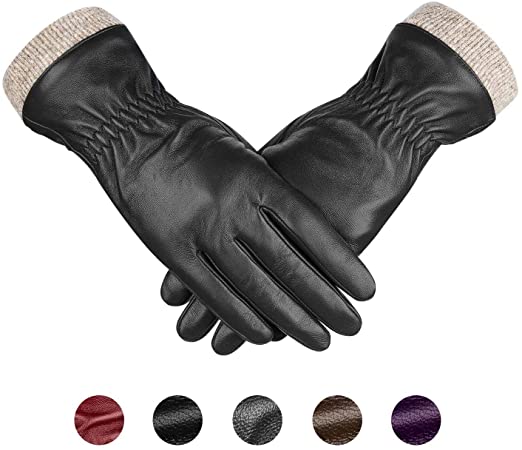Bushwalking, rambling, hillwalking, fell walking, and tramping are all words that describe hiking in various other parts of the world.
Typically hiking is a lengthy, vigorous walk outdoors for recreational purposes, either on or off trails. During the eighteenth-century Romantic movement, walking along beautiful countryside for please first came about. Before this time, walking was associated with poverty or vagrancy.
| Fahrenheit | Celsius | What to wear |
| 20 | -6 |
|
| 30 | -1 | |
| 40 | 4 | |
| 50 | 10 |
|
| 60 | 15 | |
| 70 | 21 |
|
| 80 | 26 | |
| 90 | 32 |
|
| 100 | 37 |
What To Wear Hiking In 20, 30, or 40 Degree Weather
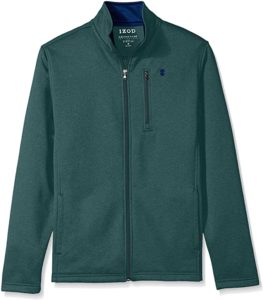 If you are inexperienced with hiking, you must be diligent with your preparation for embarking outdoors during winter. Winter can be a tricky season. Temperatures can vary from below freezing to 40 degrees.
If you are inexperienced with hiking, you must be diligent with your preparation for embarking outdoors during winter. Winter can be a tricky season. Temperatures can vary from below freezing to 40 degrees.
It could be snowing, foggy, sleeting, or raining, and even the sunlight can range from highly intense to dense, heavy cloud coverage. So, what to do? Like with fall, layers are an integral facet of winter hiking. However, you’ll need to be careful about footwear and other traction aids.
You will also need to dress for a wide range of activity levels. You are more likely to need fewer layers when vigorously pounding the trail. Conversely, you will want to bundle up when you take rest breaks. In addition to the attire you will likely wear in fall, you will want to add:
- Insulated hiking boots instead
- Sock liners to go inside your other socks
- High gaiters
- Hardshell pants – pants made of tightly woven fabricate and waterproof
- Fleece jacket
- Long underwear – to insulate your base layer
- Facemask
- Snow goggles
- SPARE CLOTHING – this is important!
- Snowshoes and microspikes – depending on weather conditions
- A backpack meant for winter hiking – these offer the ability to attach snowshoes or microspikes
Furthermore, it may be a good idea to bring extra survival gear like:
- Whistle
- Headlamp
- Firestarter
- Knife or multi-tool
- Supplies to repair your gear
- Gas stove, stove base, fuel, and pot
You may need numerous extra items when heading out on a winter trek. This mainly depends on the location and duration of your adventure. Nonetheless, you are urged to carefully and strategically prepare for any hike you plan during winter.
What To Wear Hiking In 50 to 60-Degree Weather
Fall hiking involves mastering the art of layering. You will need to find balance in your combination of base, mid and outer layers for warmth and breathability. The key here will be your fabric choices to keep yourself insulated but not overheated.
BASE LAYER:
Your foundation is essential because it will serve two purposes. This layer needs to keep you warm and help maintain your body temperature. Staple pieces could be:
- A short sleeve shirt that will wick moisture away from the skin. This is a good idea because it will keep you dry if you begin to sweat, yet it will be an excellent option if the temperature rises while you are hiking.
- Leggings are made of moisture-wicking material. For the same reason, wearing a top made of moisture-wicking fabric is a good idea. That same logic will apply to your choice of bottoms.
Your base layer should be comfy, warm, and breathable.
MID-LAYER
The importance of this layer is to provide insulation and coverage to keep you warm. Conversely, this layer should still be lightweight and offer some breathability so you can layer further. Versatile pieces for your mid-layer could be:
- A long sleeve top that has a zipper running halfway down the front. The long sleeves will provide full coverage, but having the option to unzip could provide ventilation.
- An insulated vest. A vest is lighter than an insulated jacket but still warms your core.
When picking out your clothing for this layer, strive for options that can keep you warm but not suffocated. With a shirt that has a zipper, you can have it all zipped up and trapped in heat, but if the days are milder, you can have it unzipped. The same principle applies to an insulated vest.
OUTER LAYER:
An outer layer is kind of like an optional layer. Depending on the ‘the when’ and ‘the where’ of your hiking trip, you may not need it, though it is always a good idea to pack it just in case. Regarding your outerwear, keep two features in mind: warmth and waterproof. Look for:
- A jacket that has both. There are plenty of options out there that are both waterproof and insulated. However, don’t buy into the hype of 3-in-1 jackets. These are fully insulated, have a waterproof “breathable” shell, and a mid-layer that is usually fleece or puffy. This type of jacket can be uncomfortable because they tend to bunch. They are also limiting because you are stuck with whatever mid-layer it comes.
Other outwear to pack:
- Gloves
- A hat that will keep your ears and head warm
- Waterproof hiking boots
- Wool socks
It can be tricky to figure out precisely what to wear hiking in the fall, but with a bit of practice and some trial and error, you can get down the masterful layering technique. A word of advice, it is better to over-prepare rather than under-prepared when it comes to cold weather hiking.
What To Wear Hiking In 70 to 80 Degree Weather
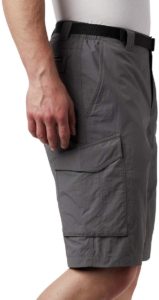 Knowing what to wear hiking in hot weather comes down to picking pieces that will keep you comfortable. However, there are a few things to consider first.
Knowing what to wear hiking in hot weather comes down to picking pieces that will keep you comfortable. However, there are a few things to consider first.
When hiking in summer, try to avoid hiking during the hottest part of the day and be sure to protect yourself against dehydration and sunburn. These simple tips can help keep you comfortable in addition to making intelligent decisions when it comes to clothing choices. Good choices include:
- Light colors – Darker colors tend to absorb the sun’s rays
- Loose and breathable clothing – Nylon and polyester are suitable materials to look for
- Clothing with open vents – There are articles specifically designed for hiking that have incorporated vents to improve airflow.
- Wearing socks that are NOT cotton – Cotton absorbs a lot of moisture which is not great for your feet. Another thing to worry about is an appropriate sock size. Too big, and you will get blisters. Too small, and there could be slippage.
- Hiking sandals – While these may not be good for prickly terrain, they are remarkably suited for warm and dry conditions. When purchasing hiking sandals, you should do your homework because fit, quality, and durability are of the utmost importance. However, this goes for all hiking footwear in general also.
Furthermore, it may seem counter-intuitive to wear long sleeves in summer. However, there is a great benefit. Choosing a lightweight, long-sleeved shirt can protect you from the sun’s damaging UV rays. So before hiking in summer or hot weather, research how to prevent heat exhaustion or stroke.
Hiking Clothes Recommendations
Wearing the right clothes depends on the trail you will be going on, what season it is and how long you will be outdoors. Fortunately, some general tips apply to all situations:
- Typically, the best clothes are synthetic materials that help keep you dry
- Pants or shorts can be okay (weather permitting). However, you don’t have to make that choice if you purchase convertible pants
- Do not wear cotton socks
- Waterproof outerwear is always preferable, even if there is no rain in the forecast.
- Hats can keep you warm as well as keep the sun off your face
- Layer as strategically as you can manage
If you need guidance for reputable brands, the following come highly rated:
- Northface
- Columbia
- Arc’Teryx
- Gossamer Gear
- Patagonia
This may have been an overwhelming amount of information and has you reconsidering hiking; however, this activity is only as complicated and demanding as you want it to be.
Technically, a could take a simple stroll down a trail in a nearby wilderness park, and that is hiking. Or, if you are advanced, you can take on the Pacific Crest Trail and try your hand at both a desert climate, mountain terrain, and long-distance all in one. While short hikes require fewer supplies and preparation, longer distances can be incredibly rewarding.
At any rate, hiking can improve mental and physical health, and it all begins with knowing what to wear when embarking on your first trail.
What to Wear While Hiking?
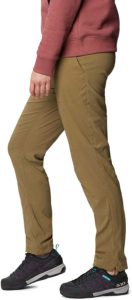
An experienced hiker will tell you, “there is no such thing as bad weather, only bad clothing choices.” You can save yourself some rough experiences by hiking inappropriate way of clothing.
Let’s discuss what pants to wear while hiking. I know what you are thinking. I said pants, and what if you are not a huge fan of pants or are worried about overheating. Well, there is a staple kind of pants that can be worn no matter the weather.
Are you ready? I have got two words for you! Convertible. Pants. These are lovely inventions because you do not have to choose between pants or shorts.
At about knee level, there’s a zipper that goes around the leg, allowing you the opportunity to detach the lower leg of the pants if you choose. Then if the weather changes or you encounter some thick brush, you can reattach the lower leg.
Viola! You are wearing a complete pair of pants again. Convertible pants are a top choice among hikers; however, they are not the only option. Other options include, but are not limited to:
- Cargo pants/shorts – Handy for storing essential items
- Hiking skirts – Some have built-in liners and could double as swimwear. Caution: Before committing to this option, consider if you are susceptible to the ever painful ‘chub rub.’ (Feel free to Google this if you are unfamiliar with the term)
- Gaiters – These are used to keep stuff out of your boots. The specific type you may need depends on the trip you plan.
You will want to avoid:
- Denim jeans – They are not weather-friendly. Depending on the temperature, you will likely end up extra hot or cold; if they get wet, they will take FOREVER to dry.
- Leggings allow for a ton of movement but do not protect your legs very well if you encounter rougher terrain.
Financially speaking, your best bet on bottoms is the convertible pants because you can use them year-round. However, there are articles you will need to compliment, depending on each season.
What are some hiking essentials?
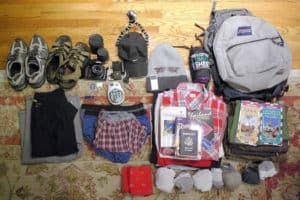 The exact things you need will vary greatly depending on the terrain, distance, and climate of each hiking trip you plan. In general, some essential items to take along may include:
The exact things you need will vary greatly depending on the terrain, distance, and climate of each hiking trip you plan. In general, some essential items to take along may include:
- A navigational device – GPS, compass, map, etc.
- Sun protection – Sunscreen, sunglasses, and other protective clothing
- A hiking backpack – It’s a good idea to have a hiking backpack if you have a serious interest in hiking. You should ALWAYS have a first aid kick in it, and it will be a great way to bring along the extra essentials that follow.
- Food – For short trips, a few snacks will do. However, it is always a good idea to be overly cautious and pack extra food for long trips.
- Water – You should bring water no matter the length of your trip, but it is always better to overestimate how much water you will need than underestimate it.
- Extra clothing – This can also apply to any hiking distance because you never know when weather conditions can abruptly change.
Knowing what to bring is half the battle when preparing for your adventure. The other half of the battle is knowing what to wear while hiking. It is essential to know what pants to wear hiking and how to dress appropriately for each season before you embark on your journey.
Why should you go hiking?
Hiking has an appeal to many people. It can reduce stress as being in nature is a great way to clear your head. This can improve mental health issues like anxiety.
Hiking is also a phenomenal way to lose weight, dramatically improving health. Being physically active can reduce your risk of heart disease and hypertension, among other dangerous conditions. Another aspect that makes hiking such an appealing hobby for many people worldwide is that literally, almost anyone can do it.
You can choose the intensity at which you do this activity by finding a place and pace that works for you. Additionally, it is a relatively inexpensive sport because minimal essentials are required.
